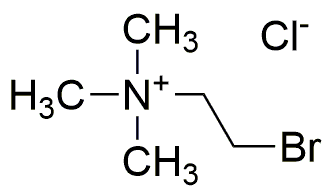(2-Chloroethyl)trimethylammonium chloride is widely utilized in research focused on:
- Pharmaceutical Development: This compound serves as an important intermediate in the synthesis of various pharmaceuticals, particularly in creating quaternary ammonium compounds that exhibit antimicrobial properties.
- Agricultural Chemicals: It is used in the formulation of herbicides and pesticides, enhancing their effectiveness by improving penetration and uptake in plant systems.
- Polymer Chemistry: The compound acts as a reactive agent in the production of cationic polymers, which are valuable in water treatment and personal care products due to their ability to bind with negatively charged substances.
- Biochemical Research: Researchers utilize it in studies involving cell signaling and membrane interactions, providing insights into cellular processes and potential therapeutic targets.
- Surface Modification: It is applied in modifying surfaces to improve adhesion properties in coatings and adhesives, making it essential in manufacturing and construction industries.
General Information
Properties
Safety and Regulations
Applications
(2-Chloroethyl)trimethylammonium chloride is widely utilized in research focused on:
- Pharmaceutical Development: This compound serves as an important intermediate in the synthesis of various pharmaceuticals, particularly in creating quaternary ammonium compounds that exhibit antimicrobial properties.
- Agricultural Chemicals: It is used in the formulation of herbicides and pesticides, enhancing their effectiveness by improving penetration and uptake in plant systems.
- Polymer Chemistry: The compound acts as a reactive agent in the production of cationic polymers, which are valuable in water treatment and personal care products due to their ability to bind with negatively charged substances.
- Biochemical Research: Researchers utilize it in studies involving cell signaling and membrane interactions, providing insights into cellular processes and potential therapeutic targets.
- Surface Modification: It is applied in modifying surfaces to improve adhesion properties in coatings and adhesives, making it essential in manufacturing and construction industries.
Documents
Safety Data Sheets (SDS)
The SDS provides comprehensive safety information on handling, storage, and disposal of the product.
Product Specification (PS)
The PS provides a comprehensive breakdown of the product’s properties, including chemical composition, physical state, purity, and storage requirements. It also details acceptable quality ranges and the product's intended applications.
Certificates of Analysis (COA)
Search for Certificates of Analysis (COA) by entering the products Lot Number. Lot and Batch Numbers can be found on a product’s label following the words ‘Lot’ or ‘Batch’.
*Catalog Number
*Lot Number
Certificates Of Origin (COO)
This COO confirms the country where the product was manufactured, and also details the materials and components used in it and whether it is derived from natural, synthetic, or other specific sources. This certificate may be required for customs, trade, and regulatory compliance.
*Catalog Number
*Lot Number
Safety Data Sheets (SDS)
The SDS provides comprehensive safety information on handling, storage, and disposal of the product.
DownloadProduct Specification (PS)
The PS provides a comprehensive breakdown of the product’s properties, including chemical composition, physical state, purity, and storage requirements. It also details acceptable quality ranges and the product's intended applications.
DownloadCertificates of Analysis (COA)
Search for Certificates of Analysis (COA) by entering the products Lot Number. Lot and Batch Numbers can be found on a product’s label following the words ‘Lot’ or ‘Batch’.
*Catalog Number
*Lot Number
Certificates Of Origin (COO)
This COO confirms the country where the product was manufactured, and also details the materials and components used in it and whether it is derived from natural, synthetic, or other specific sources. This certificate may be required for customs, trade, and regulatory compliance.


